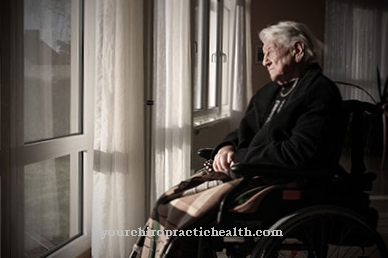Phobias are a common problem. Around 7% of people have a mild phobia, but less than 1% of the population have a severe phobia.
What is a phobia?

© topvectors - stock.adobe.com
An exaggerated fear of specific situations or things is called phobia designated. There are three types of phobias. Agoraphobia involves a fear of public places or crowds. A social phobia is a general fear of other people.
With a specific phobia, fear relates to specific things, like spiders or diseases. Those affected are usually aware that their behavior is nonsensical. However, they cannot defend themselves against their own behavior because the fear is compulsive and cannot be controlled.
causes
There are three groups of models that explain the causes of Phobias. The learning theory approach assumes that fear is “learned”. Fear is felt in an originally neutral situation. Because those affected avoid this and similar fearful situations in the future, fear is increased and those affected get into a vicious circle from which they can no longer get out without help.
The neurobilogical approach assumes that phobias have a biological cause. It is assumed that phobics have a more unstable autonomic nervous system, which can be irritated more quickly and develop faster due to its fears.
The depth psychological approach assumes that normal conflict resolution through compromise finding fails in certain situations with phobics and that fear arises as a result.
Symptoms, ailments & signs
A phobia manifests itself with typical vegetative symptoms and can also affect the psyche. It can trigger symptoms based on a specific trigger (such as arachnophobia or claustrophobia) or lead to a permanent state of anxiety. This depends on the type of anxiety disorder.
Anxiety disorders with non-everyday triggers (airplanes, clowns or the like) do not lead to long-lasting anxiety attacks. Phobias that relate to the ubiquitous, however, can.
The vegetative symptoms include profuse sweating, racing heart, nausea, the urge to defecate, the urge to urinate and tremors. Overall, the flight instinct is activated and those affected want to get out of the situation quickly. The longer you are confronted with the cause of your fear, the more the symptoms become worse. They also include fainting in some cases.
On the psychological level, the fear of losing control dominates. In addition, there is occasionally the feeling of standing next to oneself (depersonalization) or fear of a (negatively) changing environment. A phobia can accordingly lead to strong avoidance behavior in the person affected. He then does everything possible not to meet the trigger for his fear. Avoidance behavior is detrimental to different degrees, but not infrequently leads to negative moods.
Diagnosis & course
To make a reliable diagnosis of a phobia other psychological and also some physical illnesses must first be excluded. These include depression, schizophrenia, bipolar disorder, and obsessive-compulsive disorder.
Physically, hyperthyroidism or heart disease should be ruled out as the cause. Special questionnaires help with the diagnosis. A distinction is made between external and self-assessment sheets. Agoraphobia usually occurs in situations and in places where those affected fear that they will not be able to escape.
Agoraphobia is a kind of claustrophobia and means an increasing restriction of freedom of movement, which can ultimately make a normal life impossible. Agoraphobia is often accompanied by panic disorders.
With a social phobia, those affected fear being in the presence of others People fail. Some of the fears have severe effects on social life and go far beyond normal shyness. A social phobia is often accompanied by other psychological problems, such as depression, other phobias or addictions. Men are less affected by social phobias than women.
The fears associated with specific phobias only occur in certain situations or with certain objects. Typical situations for specific phobias can be confined spaces, air travel, tunnels, motorway journeys or dental treatments (see fear of the dentist). Typical objects that trigger specific phobias are animals such as spiders, snakes or mice, blood, syringes and injuries.
People with a specific phobia know very well that their fear is actually unfounded. However, they cannot control it and therefore come to terms with their phobia by avoiding the fear-inducing situations or objects. A specific phobia only reaches an actual disease value when everyday life is severely restricted or impaired.
Complications
Phobias often coexist with other phobias and other anxiety disorders. Many people suffer from more than one specific phobia and are, for example, afraid of dogs (canophobia) and spiders (arachnophobia).
One possible complication is agoraphobia, in which those affected increasingly withdraw and avoid situations in which they could expose themselves. Agoraphobia can lead to complete social isolation: some agoraphobics rarely leave their home.
All types of phobias often appear together with depressive disorders. To regulate anxiety, some phobics resort to medication, alcohol, tobacco or drugs. Others engage in self-harming behaviors or develop abnormal eating habits. Phobias and other anxiety disorders can also promote physical illness.
The increased stress level increases the risk of cardiovascular diseases. Phobics who are afraid of doctors, needles or blood also often avoid medical examinations. This can lead to further complications: People with dental phobia often only go to the dentist when they are in severe pain. As a result, not only do they physically suffer longer and more severely than necessary, but the condition of the teeth, as a rule, also deteriorates.
When should you go to the doctor?
People who suffer from severe fears that go far beyond a natural fear sensation should consult a doctor or therapist. If you experience stress in different situations, if the number of anxiety triggers increases or if everyday obligations can no longer be fulfilled, a doctor's visit is necessary. Limitations in lifestyle, social isolation and changes in personality indicate the need for treatment.
A doctor's visit is advisable so that a treatment plan can be drawn up and a gradual improvement in health occurs. A restricted quality of life, decreased well-being and a loss of zest for life are signs of a mental disorder. Sweating, palpitations, insecurities or a physical numbness in a fear-inducing situation should be discussed with a therapist. A doctor should be consulted in the event of hyperventilation, tearfulness and restlessness. Avoidance behavior is typical of a phobia.
The lifestyle is continually restricted and the inner discomfort increases. The disease is characterized by a steady increase in symptoms over several years. Often professional activities can no longer be carried out and participation in leisure activities hardly takes place. If the person concerned no longer leaves their own home, they need help. If interpersonal conflicts increase or vegetative dysfunction develops, a doctor should be consulted.
Treatment & Therapy
Usually one will phobia treated by behavioral therapy. In some cases, additional medication treatment is necessary. Systematic desensitization and flooding therapy are particularly effective. In the case of systematic desensitization, the patient is initially provided with complete relaxation. This is followed by a gradual introduction to the fear trigger.
This procedure ensures that the phobic person gradually loses his fear and, after successful therapy, can face the fear trigger without fleeing from it. Flooding therapy "floods" the patient with the fear trigger. During therapy, the phobic person learns with the support of the therapist that the greatest fear eventually subsides when he endures the frightening situation and perseveres.
After such an experience, the trigger of the phobia has almost no power over the person concerned. Medication is sometimes used to treat social phobias in particular. Mostly these are antidepressants. Sedatives and beta blockers are also used.
You can find your medication here
➔ Medicines to calm down and strengthen nervesOutlook & forecast
An adult phobia rarely heals completely. The disease accompanies those affected for years. If the person concerned is aware of their fears and has learned how to deal with the phobia appropriately through behavioral therapy, the prognoses are usually favorable. The prospect, however, depends on the severity of the disease and cannot be generalized.
If the phobia is slightly pronounced, the (treated) patient can lead a largely symptom-free life. Severe anxiety disorders will affect the person even after the treatment has been completed. They mostly become chronic. In the case of severe social phobia, the person concerned can often not return to his or her place of work. The consequences are a change of job or even disability. This course can also cause depression. Further psychotherapy is necessary. Secondary diseases always have a negative effect on the prognosis.
The patient can do his part by using the advice of his psychotherapist in everyday life. He has become aware of which situations trigger fear in him and for what reason. An agoraphobic will deliberately bypass free places. Such behavior is not a sign of weakness, but of a conscious handling of the disease.
prevention
Anyone who does not flee from them after fearful situations or experiences and does not transition into active behavior to avoid them can be as good as possible before the outbreak of a phobiaprotect. In addition, if you suspect you should consult a doctor or psychologist in good time to nip the phobia in the bud from the very beginning.
Aftercare
The phobia is a mental illness in which the success of the treatment is ideally supported by consistent follow-up care. It is important, as is usually learned in behavior therapy, not to avoid contact with objects or situations that trigger fear. It is important for those affected to find out again and again after the treatment that these things are harmless and do not involve any danger.
The more often this is practiced, the more stable the therapeutic success with regard to the respective phobia. Visiting a self-help group can be valuable support in this context, as conversations can result in a good exchange of experiences and helpful tips. Relaxation methods are often an effective element for illnesses that are associated with anxiety, which those affected can effectively incorporate into aftercare.
There are several methods here. For example, Jacobsen's progressive muscle relaxation and autogenic training come into question. In addition, yoga often rebalances and heals through a combination of physical exercises (asanas), breathing exercises (pranayama), meditation and relaxation. The trust in your own body comes back and mind and soul can regenerate. Walks and endurance training also strengthen the normal body awareness of those affected and make a useful addition to aftercare.
You can do that yourself
The quality of life of a person affected by a phobia depends on their type. For example, if the phobia relates to animals, such as spiders or cats, and activities such as driving a car, train or flying, then life can be shaped relatively well by using these Avoiding things. However, other phobias can have a significant impact on everyday life.
If you are afraid of large crowds, small rooms and certain noises, the person concerned has to restrict himself when choosing an apartment and career. The people with whom one has daily dealings should be made aware of the illness so that there are no embarrassing incidents, but rather help can be provided immediately. If a situation emerges in which the phobia comes to light, the person affected should not be afraid to inform his fellow human beings that he must get out of it immediately.
It is always helpful to visit a doctor or therapist with a phobia in order to get a grip on it or at least to be able to live with it. Sufferers need to learn that the situations they are afraid of are not dangerous. You can only do that if you put yourself in these situations. A therapist, or in milder cases a close friend or relative, can accompany this so that the person concerned is not overwhelmed.

























.jpg)

.jpg)
